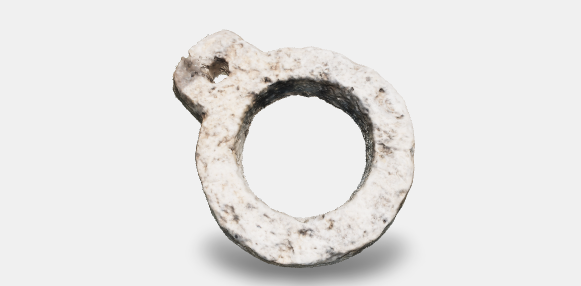Stone anchor, “doughnut”-shaped. Stone not very compact, of grey colour with bluish veins. Stone ring with an apical square grip. Both the internal and external hoops are not compass-shaped. The use of the artefact as a deadweight for fishing nets may not be ruled out (1).
The anchor presents an eroded surface due to the motion of waves and sediment, with a sporadic presence of epilithic encrusting organisms. The presence of Polychaeta serpulidae is visible thanks to their characteristic calcareous tube.

MEDAGLIA 2002, p. 177
1 See PULAK, TOWNSEND ET AL. 1987, p. 40, fig. 8 (marble specimen, with a top grip with two holes).
REFERENCES
Medaglia S. 2002, Materiali erratici dal mare di Kaulonia, in Archeologia Subacquea, Studi Ricerche, Documenti, III, pp. 163-185.
Pulak C., Townsend R.F., Koehler K.G., Wallace M.B. 1987, The Hellenistic Shipwreck at Serçe Limanı, Turkey: Preliminary Report, in American Journal of Archaeology 91, No. 1 (Jan., 1987), pp. 31-57.
Many scholars studied the so-called lithic anchors (1). Honor Frost, Dan E. McCaslin, Alessandra Nibbi, Shelley Wachsmann and János Attila Tòth produced chronologies and tables, often conflicting among each other (2). We can therefore confirm that this type, rightly because of its simplicity, is undoubtedly very ancient and recurs since the Bronze age, as evidenced by the specimens found in the sanctuary of Ugarit (3). As stated by McCaslin, the dating may not be narrowed down only to this period, considering that the wrecks of Antidragonera and Ognina D contained some of them (4). The same could be said for Frost’s theories who at the end of the 1990s argued that they were on board of Phoenician ships only and that they were abandoned in the Iron Age due to their weight (5).
As a demonstration that this particular type of anchor was used during a wider time span, we can mention the artefacts from the Medieval period (XIV century) with one or more holes, published by Avner Raban and originating from the port of Cesarea with ascertained and sealed stratigraphies (6). Raban has also documented their use in Italy in recent times (7).
Moreover, it is certain that many of these artefacts were not only used for anchoring. Some particular shapes may indicate their use in fishing, as deadweights or repurposed threshing stones (8).
NOTES
1 As far as Italy is concerned, we would like to mention Piero Alfredo Gianfrotta with Patrice Pomey, Gerard Kapitän and Edoardo Riccardi (GIANFROTTA, POMEY 1981; KAPITÄN 1984; RICCARDI 1996).
2 FROST 1973; MCCASLIN 1980; NIBBI 1993; WACHSMANN 1998; TÒTH 2002.
3 FROST 1969.
4 Both wrecks from the IV century B.C. See KOURKOUMELIS 2000, p. 241 and 2004; GIBBINS 2001, p. 225.
5 FROST 1997. The hypotheses presented by McCaslin and Frost have been discussed and questioned by other scholars. See for example, GIANFROTTA 1983; KINGSLEY 1996; ID. 1994; RABAN 2000.
6 RABAN 2000
7 See also RABAN 2000.
8 See also GIANFROTTA 1983 and GALASSO 2000, pp. 265-282.
REFERENCES
Frost H. 1969, The stone anchors of Ugarit, in Ugaritica 6, pp. 235-245.
Frost H.1973, Anchors, the potsherds of marine archaeology: on the recording of pierced stones from the Mediterranean, in D.J. Blackman (Ed.), Marine Archaeology, London, pp. 397-406.
Frost H. 1997, Bronze age stone anchors (Eastern Mediterranean), in J.P. Delgado (ed.), Encyclopaedia of Underwater and Maritime Archaeology, London, pp. 74-75.
Galasso M. 2000, Ancore di pietra fra archeologia ed etnografia, in Archeologia Postmedievale, 4, pp. 265-282
Gianfrotta P. A., Pomey P. 1981, Archeologia subacquea, storia, tecniche, scoperte e relitti, Milano.
Gianfrotta P.A. 1983, Review of Dan E. McCaslin: Stone Anchors in Antiquity, in Gnomon 55, pp. 336-339.
Gibbins D. 2001, Shipwreck and Hellenistic trade, in Zofia H.A., Davies J., Gabrielsen V., Oliver G.J. (eds.), Hellenistic Economies, London-New York,
Kapitän G. 1984, Ancient Anchors – Tecnology and Classification, in IJNA 13.1, pp. 33-44
Kingsley S.A., Raveh K. 1994, Stone anchors from Byzantine contexts in Dor Harbour, Israel, in IJNA 23, pp. 1-12
Kingsley S.A., Raveh K. 1996, The Ancient Harbour and Anchorage at Dor, Israel. Results of the underwater surveys 1976-1991, BAR Int. Series 626, Oxford.
Kourkoumelis D. 2000, The Antidragonera Wreck (Kythera, end of 4th century BC), Island in Archaeology: Vorgeschichte, Klassische Antike, Mittelalter, Neuzeit (Internationaler Kongress 10-12 Juli 1998, Starnberg), in Archäologie unterWasser 3, München,
Kourkoumelis D. 2004, Les ancres pyramidales en pierre. Problèmes et techniques d’ancrage des navires au IV siècle av. J.-C., in Brun J.P., Philippe J. (eds.), Texnai. Techniques et societès en Mèditerranèe, Paris, pp. 649-661.
Mccaslin D.E. 1980, Stone Anchors in Antiquity: Coastal Settlements and Maritime Trade-Routes in the Eastern Mediterranean ca. 1600-1050 B.C., Göteborg.
Nibbi A. 1993, Stone anchors: the evidence re-assessed, in The Mariner’s Mirror 79, pp. 5-26.
Raban A. 2000, Three-hole composite stone anchors from a medieval context at Caesarea Maritima, Israel, in IJNA 29.2, pp. 260-272.
Riccardi E. 1996, Ancore, in Ciciliot F. (ed), Navalia – archeologia e storia, Savona, pp. 9-30
Tòth J.A. 2002, Composite stone anchors in the ancient Mediterranean, in Acta Archaeologica Academiae Scientiarum Hungaricae 53, pp. 85-118.
Wachsmann S. 1998, Seagoing Ships and Seamanship in the Bronze Age Levant, College Station- London .



